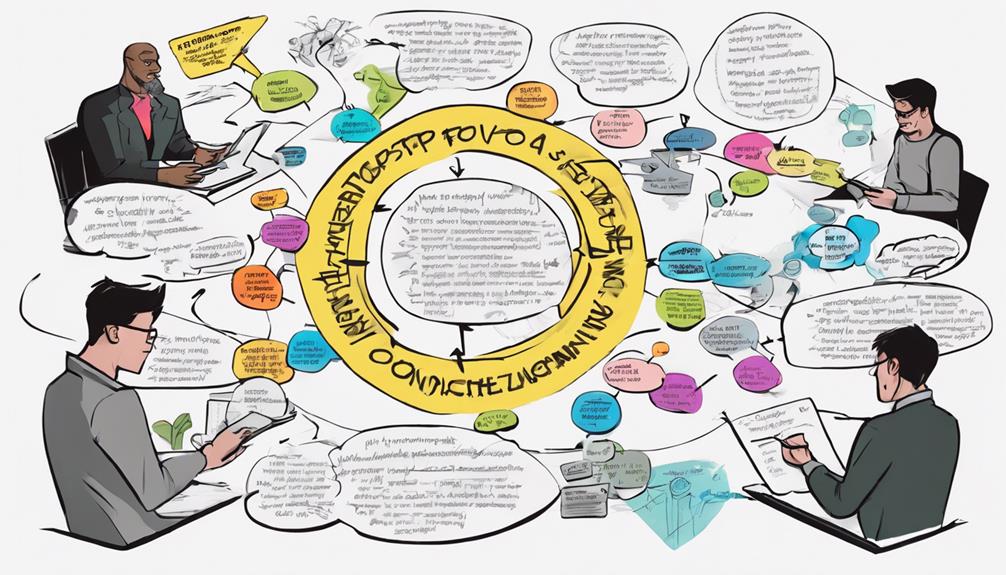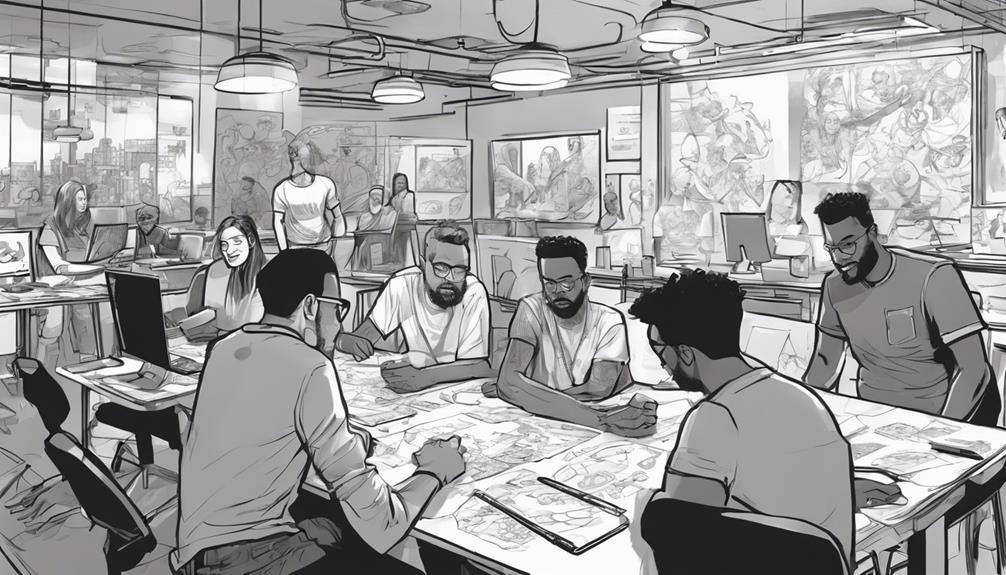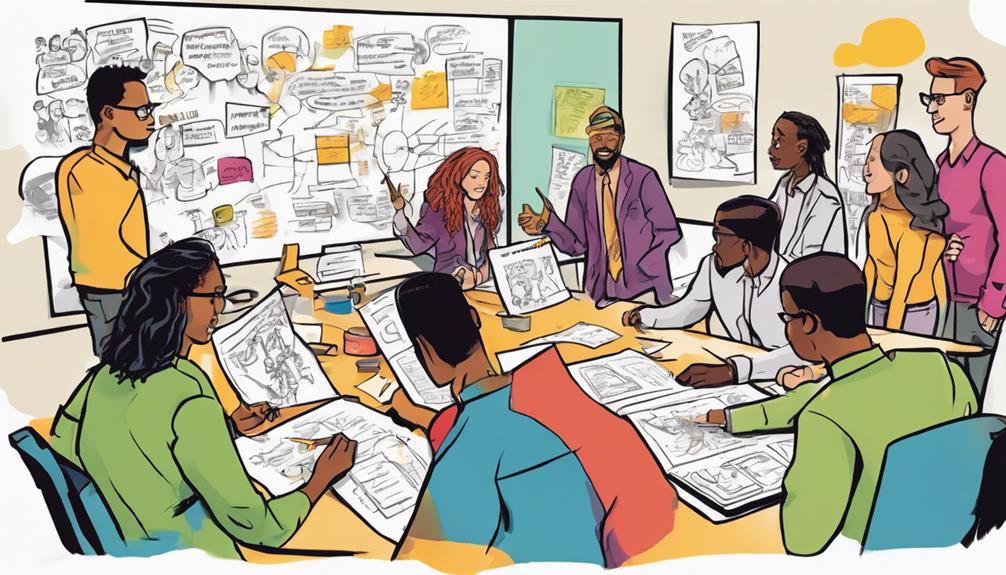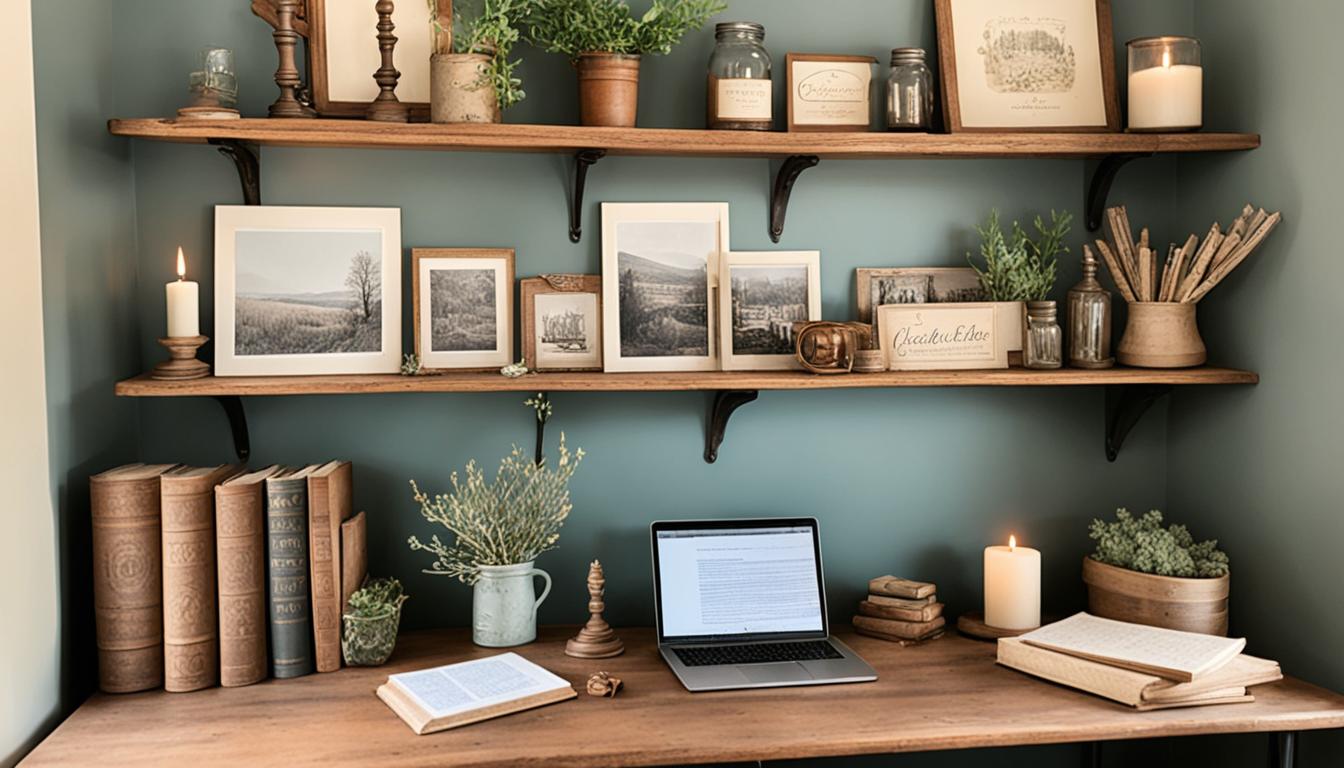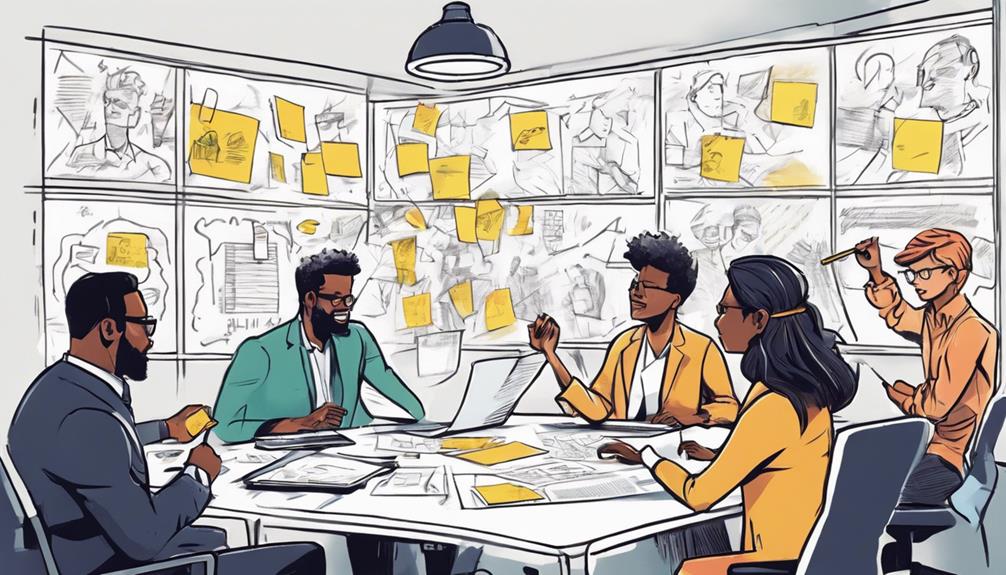Within the Design Thinking Model, the architectural runway is an essential element that balances emergent design with planned guidelines, ensuring continuous value flow in Agile projects. It plays a key role in guiding the development process and supporting the evolution of technology landscapes. Understanding its significance is vital for successful goal attainment in large solutions. The architectural runway acts as a foundation for effective Agile project management.
Key Takeaways
- Architectural Runway is a key aspect of the Design Thinking Model's planning and execution phase.
- It aligns with the strategic goals and execution strategy in Agile projects.
- Supports development by guiding enablers and technical foundations for design solutions.
- Facilitates sprint enabler management for timely completion of architecture-related tasks.
- Enhances the development handoff process by structuring clear communication and coordination.
Definition and Importance
Understanding the definition and importance of the architectural runway is essential to grasping its role in the design thinking model. The architectural runway serves as a planned set of guidelines crafted by Enterprise, Solution, and System Architects. It plays a critical role in enabling the continuous flow of value through the Continuous Delivery Pipeline.
By incorporating intentional architecture, the architectural runway strikes a balance between emergent design and planned guidelines, thereby averting delivery costs and delays.
Continuous investment in the architectural runway is crucial as it allows Agile teams to evolve the technology landscape and enhance solution performance. Particularly for large solutions involving multiple Agile Release Trains (ARTs), the architectural runway is indispensable in ensuring effective goal attainment.
Components and Implementation

Architectural Runway components play a pivotal role in guiding Agile teams towards implementing deliberate architecture within the design thinking model. Enabler Stories are used by Agile teams for emergent design within the Architectural Runway, while deliberate architecture guidelines are crafted by Enterprise, Solution, and System Architects. These components are codified at various backlog levels to ensure a systematic approach to implementation. Architects steer enablers through Kanban systems, facilitating the translation of deliberate architecture into actionable steps for Agile delivery. Balancing components within the Architectural Runway is essential to avoid bottlenecks and maintain a smooth flow of work.
| Architectural Runway Components | Implementation Importance |
|---|---|
| Enabler Stories | Facilitate emergent design |
| Backlog Levels | Codify components |
| Kanban Systems | Guide enablers |
| Balancing Components | Avoid bottlenecks |
Continuous Investment

For best results, sustain ongoing investment in the architectural runway to keep up with evolving business demands. Continuous investment guarantees the runway's flexibility to changing business needs.
Agile teams play a pivotal role in extending the architectural runway through activities like automation and DevOps. This extension allows teams to improve delivery velocity and efficiency by supporting the evolution of the technology landscape.
As teams consume the runway by delivering features, the need for ongoing investment becomes evident to maintain its effectiveness. By committing to extending the runway in each iteration, Agile projects benefit from improved efficiency in the development process.
The architectural runway serves as a foundation for Agile teams to navigate the complexities of changing business requirements, highlighting the importance of consistent investment to drive success in delivering value to customers efficiently.
Role in Large Solutions

To effectively guide multiple Agile Release Trains (ARTs) in large solutions, the architectural runway plays a pivotal role in ensuring alignment and success.
In complex solution environments, intentional architecture is essential for maintaining cohesion and achieving objectives.
Within large-scale solutions, the architectural runway is extended through enabler epics that span multiple Program Increments (PIs), laying the foundation for continuous improvement and adaptation.
Ten essential Lean-Agile practices, including intentional architecture, are critical for successful solution delivery in extensive contexts.
The collaboration between Solution Intent, defined constraints, and the architectural runway is key to maneuvering the challenges of large solutions.
Benefits and Significance
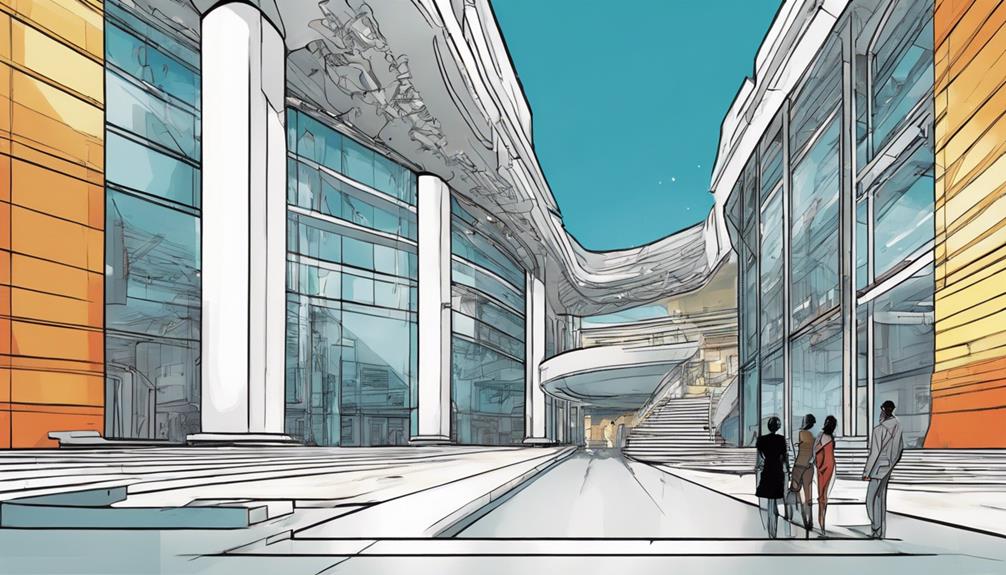
You must understand the significance of the architectural runway and the value it brings to the design process.
It plays a vital role in maintaining a steady flow of value in Agile projects and helps in preventing delivery costs, delays, and security risks.
Embracing intentional architecture alongside emergent design guarantees efficient evolution of solutions, enhancing performance and time-to-market.
Importance of Runway
Consistently investing in the architectural runway is pivotal for guaranteeing the smooth flow of value and maintaining the quality of Agile projects. The runway serves as the foundation for Agile development, providing intentional architecture that supports the evolving needs of solutions.
By incorporating key features and user requirements into the architecture from the outset, the runway enables teams to adapt and evolve with changing technology landscapes. Investing in the runway early on helps prevent delivery costs, delays, security vulnerabilities, and ensures high-quality software development.
Additionally, the architectural runway plays a vital role in large solutions with multiple Agile Release Trains (ARTs), providing the necessary intentional architecture to achieve business goals efficiently.
Continual investment in the runway is essential to extend its capabilities and support the evolving demands of Agile teams and shifting business requirements, ultimately contributing to the success of Agile projects.
Value in Design
The underlying value of the architectural pathway in the design thinking model becomes evident through its ability to enhance solution performance and streamline time-to-market efficiency.
Agile architecture thrives on the architectural pathway, allowing for the evolution of the technology landscape with intentional architecture while embracing emergent design. This balance not only prevents delivery costs, delays, and security issues but also ensures continuous flow of value through the delivery pipeline.
By improving solution performance, economic outcomes, and time-to-market efficiency, the architectural pathway plays a pivotal role in driving successful and cost-effective releases. Its significance lies in safeguarding against poor quality and delays, guaranteeing swift and economical delivery of solutions.
Embracing the architectural pathway within the design thinking model isn't just a strategic choice but a necessity to navigate the complexities of modern technology landscapes and achieve best results.
Evolution and Strategies
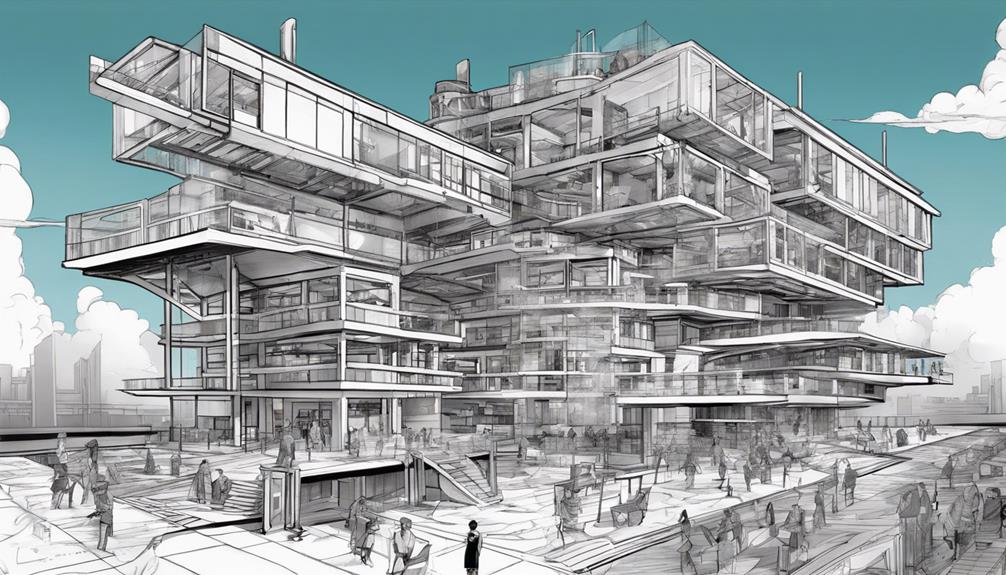
To navigate the evolution of architectural runway effectively, consider implementing a mix of intentional architecture and emergent design strategies.
The architectural runway facilitates incremental evolution by breaking down enabler epics into manageable features and capabilities for implementation within Program Increments. Following simple Agile rules for building the runway is essential, focusing on intentional architecture to support future development. Continual investment in enablers is necessary to extend the runway's capabilities and guarantee its relevance over time.
Balancing intentional architecture with emergent design is vital for effective evolution strategies, allowing for flexibility while maintaining a solid foundation for growth. By combining intentional planning with the ability to adapt to changing requirements, teams can maximize the potential of their architectural runway and drive successful evolution of their solutions.
Agile Project Contribution

By integrating the architectural path into Agile projects, you enhance the alignment between business requirements and design concepts. Agile architecture focuses on delivering smaller, scoped enabler deliverables that are essential for effective communication and successful implementation in the Agile sprint cycle.
The architectural path precedes development tasks, refining business requirements and making development stories shovel-ready. Enabler deliverables are strategically mapped to sprints ahead of the development effort, ensuring a smooth shift and minimizing delays.
Effective communication and handoff between architects and developers are essential components for the seamless integration of architectural path components into Agile projects. This collaborative approach ensures that design concepts are effectively translated into actionable development tasks, streamlining the overall project workflow.
Planning and Execution

You need to focus on aligning your execution strategy with the architectural runway, managing enabler deliverables within sprints effectively.
Make sure the development handoff process is well-defined to ensure a smooth handover between architecture and implementation.
The key lies in strategically managing timing and dependencies to guarantee successful planning and execution of design tasks.
Execution Strategy Alignment
Effective planning and execution in the Design Thinking Model involve aligning the Architectural Runway with the project's Execution Strategy to guarantee strategic goals are supported by the technical foundations.
The Architectural Runway serves as the backbone that confirms the design implementation aligns with the project's strategic objectives. By integrating the Architectural Runway with the Execution Strategy, enablers and technical foundations are developed to support the execution of design solutions effectively.
This alignment aids in prioritizing architectural work alongside sprint tasks, enhancing the project's scalability, quality, and overall success. The Architectural Runway acts as a guiding force, ensuring that the technical aspects of the project are in sync with the strategic goals set forth.
This synchronization is essential for achieving a successful outcome that meets the desired objectives while maintaining a high level of quality and scalability throughout the execution phase.
Sprint Enabler Management
Sprint enabler management entails strategically planning and executing architecture runway tasks in coordination with sprint deliverables. To effectively manage sprint enablers, consider the following:
- Mapping Enabler Deliverables: Align enabler deliverables with specific sprints to guarantee timely completion of architecture-related work.
- Coordinating Dependencies and Timing: Take into consideration dependencies and timing to synchronize architecture tasks with sprint activities seamlessly.
- Leveraging Architectural Experience: Strategically utilize architectural expertise to lead development efforts in high-value areas.
- Ensuring Effective Communication and Handoff: Facilitate clear communication and smooth handoff processes between architects and developers for successful implementation of the architecture runway within sprints.
Development Handoff Process
To streamline the progression from architectural planning to development, a structured approach to the handover process is essential. The development handover process involves mapping enabler deliverables to sprints ahead of development efforts, ensuring that timing and dependencies are carefully considered to align architectural work with the development phase.
Leveraging architecture experience in high-value areas allows for effective leadership in development efforts. It's important to avoid overloading architects with tasks to maintain quality and accountability in the handover process.
Consistent communication between architects and developers is paramount for successful implementation, facilitating the transfer of knowledge and ensuring a smooth handover from planning to execution. By establishing clear communication channels and aligning deliverables with sprint timelines, the development handover process becomes a collaborative effort that maximizes efficiency and effectiveness in bringing architectural designs to life.
Frequently Asked Questions
Which Aspect of Design Thinking Model Is the Architectural Runway a Key Part Of?
In the design thinking model, the architectural runway plays a pivotal role in the 'Define' phase. It sets the foundation for a smooth design process, aligning design goals with technical implementation. Establishing it early prevents bottlenecks and guarantees cohesion.
What Is the Architectural Runway?
The architectural runway is a planned set of guidelines for Agile teams implemented through enabler Stories. Continual investment is essential to extend the runway and support value flow. It guarantees teams have the technical foundation for efficient feature delivery.
What Is One Method for Developing a Sufficient Architectural Runway?
To develop a sufficient architectural runway, you can start by setting clear architectural guidelines and investing continuously in its growth. This practice guarantees that your Agile teams have the support they need to deliver effectively.
What Is the Role of Architecture in Agile?
In Agile, architecture serves as an essential link between business needs and project success by translating ideas into design. Collaborate closely with senior developers to guarantee effective implementation. Deliver smaller, scoped deliverables for improved engagement.
Conclusion
You may be thinking, 'But isn't the architectural runway just another step in the design process?'
However, the architectural runway is pivotal in ensuring the success of a project by providing a solid foundation for future development and innovation.
By continuously investing in and evolving the architectural runway, teams can effectively plan and execute large solutions in an agile manner, leading to numerous benefits and significant advancements in the design thinking model.



